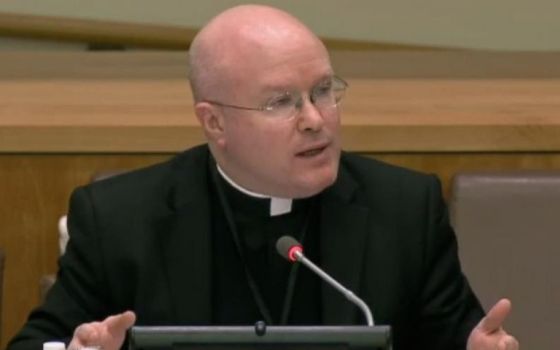Fr. Roger J. Landry is a priest of the diocese of Fall River, Massachusetts, and is also Attaché and Director of Special Events for the Permanent Observer Mission of the Holy See to the United Nations.
The Holy See mission to the U.N. and ADF International, a religious freedom advocacy organization, are sponsoring a two-part celebration of Mother Teresa and her work during the week following her Sept. 4 canonization and in anticipation of the 70th anniversary of the founding of the Missionaries of Charity on Sept. 10. This includes a Sept. 6-9 exhibit at the U.N.
Landry, 46, recently spoke to GSR about the exhibit and the celebration of the life of Mother Teresa.
GSR: Tell us about the exhibit and why the U.N. is the site of the exhibit. We don't normally think of Mother Teresa in the context of the U.N.
Landry: When Mother Teresa spoke to the U.N. General Assembly in celebration of its 40th anniversary in October 1985, then-Secretary General Javier Pérez de Cuéllar called her the 'most powerful woman in the world' and said, 'She is the United Nations. She is peace in the world.' We think her life remains a guiding light for the work of the U.N.
The first part of this celebration and consideration will be a weeklong exhibition in one of the main thoroughfares of the U.N. [building] focused on her life; her work as a peacemaker and peace builder that led her not only to win the Nobel Peace Prize but to war-torn areas like Beirut; her care for all those often left behind by society — a focus of the 2030 Agenda for Sustainable Development — like the dying, orphans, refugees, the homeless, lepers, AIDS/HIV victims, the unborn and more; and her particular care for the poor one-by-one, ensuring that poverty never remains just an economic or social issue but always retains the interpersonal and human dimension.
The second part will be a conference on Sept. 9 focused on the three themes of peace, leaving no one behind, and care for the poor, which are all high priorities on the U.N. agenda and about which Mother Teresa's words, work and witness have much to say.
For the Sept. 9 conference, the Missionaries of Charity in the New York area are bringing in several busloads of those they serve in their various residences and soup kitchens in order to see the display and attend the conference. Afterward, we are hosting a catered meal for them, for the Missionaries of Charity and their co-workers, along with speakers and ambassadors in the parish hall of the Church of the Holy Family across the street from the U.N. in celebration of Mother Teresa's canonization.
What are the international implications of Mother Teresa's work? How does her example live on in the international context aside from the very strong and continuing work of her congregation, the Missionaries of Charity?
For all its strengths, sometimes the approach to peacemaking and peace-building, to poverty and development issues at the international level can be overly technocratic, bureaucratic and systemic. Mother Teresa always placed the person, especially the most vulnerable, in the heart of her understanding, advocacy and direct care in all of these areas.
That approach remains enormously relevant today in its applications to issues of justice, peace, the economy, integral development, the environment, the right to life, health care, and so many others. It's always important to teach people how to fish, but Mother Teresa first strived to ensure that people first received the fish they needed to survive and to stand up and to hold a rod.
In an international context often dominated by statistics, by billions of people and trillions of dollars, she helps us not to forget the invaluable dignity and inestimable worth of every person. The Missionaries of Charity are the institutional legacy that helps the whole world not to forget.
What is her enduring message?
I think her enduring message is about authentic charity. She was a missionary of loving concern and solidarity for those so often left on the margins, sacrificing her life to care for those whom no one else cared for. She did it not as a social worker or altruistic philanthropist, but as a believer in God whose faith was totally consequential. Because she believed that God infinitely loves every person — young or old, man or woman, healthy or sick, wanted or unwanted, powerful or vulnerable. She sought to live according to that love and to invite others to do likewise. She became the beautiful, wrinkled face of the Good Samaritan and showed us all how to cross the road with her.
There is often talk at the U.N. about enduring solutions to poverty and other social ills, and sometimes the 'charity model' is criticized as not going far enough. Do you think Teresa and her order were and are able to perhaps bridge the gap between these differing views of solutions to poverty?
The charity model doesn't go far enough because, frankly, not enough people are charitable. For that reason, way too many people would fall through the cracks if their situations needed to be alleviated solely by the random kindnesses and sacrificial charity of the few. Even the institutionalized charity of the Missionaries of Charity, Caritas, and so many faith-based organizations is insufficient to remedy the scale of various social problems. Addressing the problems systemically at their roots is obviously required, as the international community has been striving to do, for example, with the Millennium Development Goals and the Sustainable Development Goals.
At the same time, however, as Pope Benedict XVI mentioned in Deus Caritas Est, even the most just structures and most competent personnel are likewise inadequate because people need more than technically proper assistance: They need heartfelt concern. That's what Mother Teresa taught us all and continues to teach us through the Missionaries of Charity, who help all of us, including those who work in international programs, to learn how to be missionaries of charity, without which they wouldn't be meeting all of the human needs of those whom they seek to help. Rather than bridging the gap between giving fish and teaching how to fish, Mother Teresa makes sure that we don't forget, that we never forget, that we're dealing with persons who not only need fish and piscatorial education, but love and humanity.
[Chris Herlinger is GSR international correspondent. His email address is cherlinger@ncronline.org.]

